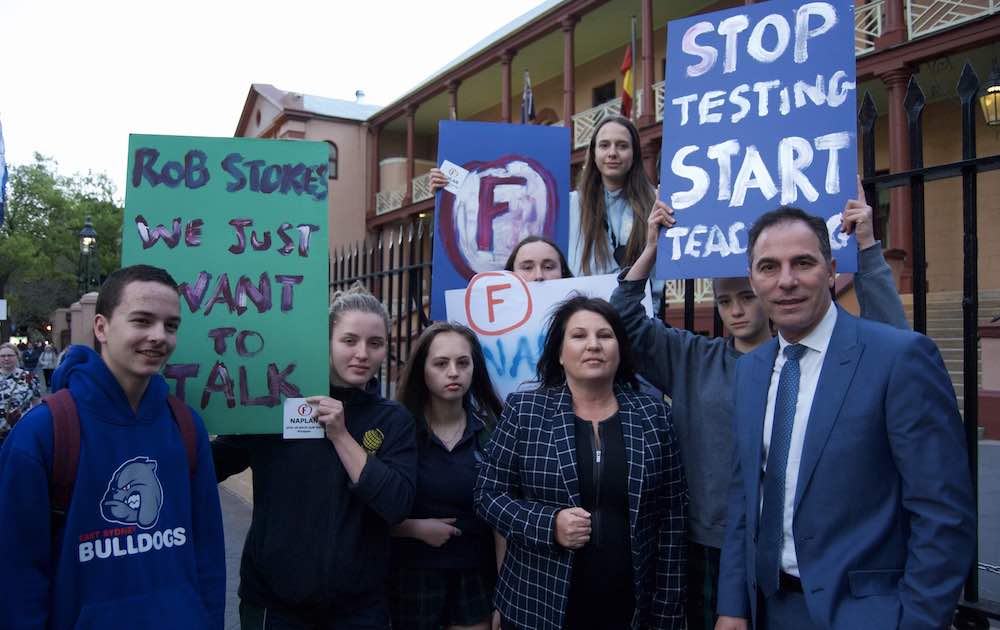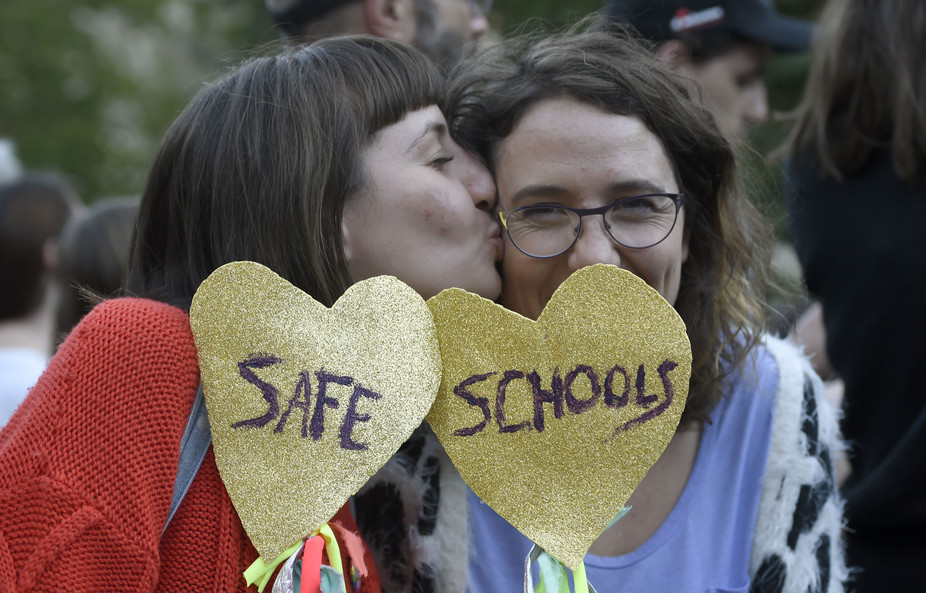Don’t say “passed away”: handling suicide and grief for teachers

Grief is part of life but for teachers it is a chronically overlooked part of the job.
In the classroom, grief has many faces… Teachers can experience feelings of pressure to identify at-risk kids, confusion about language-use and a lack of support for their own grief. Above all, teachers have told us they struggle to strategise around suicide and suicidal ideation.
Out of respect for privacy, School News has not named or identified any of the teachers, former students or schools included in this article.
This article was written for our print publication. Have you received your Term 1 issue? Click here to read the digital copy online now.
The statistics are shocking
Seventy percent of mental illness and suicidal behaviours begin between the ages of 12 and 25 in Australia, according to Suicide Prevention Collective.
For every completed suicide there are 30 attempts nationwide. Twenty-one young Queenslanders and 15 young people in Western Australia ended their lives between 2010 and 2012 alone. 2016 saw the highest rate of youth suicide in 10 years, then there was a nine percent rise the following year, according to Australian Bureau of Statistics data. Queensland had the largest increase of any state in 2017. In 2018, almost one person a week ended their life in the Northern Territory. Youth suicides are twice as likely to happen in clusters than adult suicides and just this past January, a 12-year-old Indigenous girl in NT ended her young life and perhaps most upsettingly, rates of suicide are increasing for children under 14.
Secondary school is a critical time for suicide prevention and mental health awareness, as a 2017 survey of Australian tertiary students between the ages of 17 and 25 revealed that 35 percent had experienced self-harm or suicidal ideation in the previous 12 months. Noticing warning signs, providing support and developing strategies for self-care in middle and senior school is essential if we want to change these statistics.

What to do when a student expresses suicidal thoughts?
School News spoke with a state school teacher in Queensland who said: “Kids do go to the guidance officers but a lot of those kids have trust issues, so they want to go to speak to their favourite teachers but we aren’t trained in helping them, so we’re supposed to refer them to the GOs. What are we supposed to do? Not talk to them?”
Mental health campaigns frequently encourage students to talk to trusted adults, and the designated ‘trusted adult’ in a school is the guidance officer or chaplain. But according to Black Dog Institute’s mental health report on 15-19-year-olds, just as many kids would seek help from a teacher as a school counsellor. So, shouldn’t teachers be better trained on how to respond when a student confides suicidal ideation or other mental health issue?
Students may not be aware that teachers have a duty of care to report what they have said, so educational psychologist Michele Blick advises: “If a student approaches a teacher with concerning behaviour, the teacher needs to remain calm and attentive, acknowledge and validate the student’s feelings of distress and express empathy; listen without judgement, thank the student for trusting her/him to share this information, and inform the student that s/he will need to get someone else to assist. The teacher can continue to show support for the student by checking in with the student and reminding the student of the support that is available.”

Ask the student to clarify intent
If you think someone might be having suicidal thoughts you must take immediate action. Headspace advises to ask them directly whether they are having suicidal thoughts, and whether they have a plan in mind. “This will not ‘put thoughts into their head’ and is vitally important in assessing their risk of suicide.”
Specialist bereavement counsellor from the National Centre for Childhood Grief, Dr Dianne McKissock provides context: “The majority of people say things like ‘I wish I was dead’ or ‘if it wasn’t for X, I’d kill myself’. It is rare for people to act on those words. If anyone sounds or appears suicidal it’s important to listen empathically, then clarify intent. Ask questions like, ‘Are you telling me you feel so bad at the moment that you wish you didn’t have to wake up in the morning, or are you telling me that you really intend to kill yourself?’
“If they answer yes to the first part of the question, ask something like, ‘What do you really need me to understand?’ If yes to the second part, ask if they have a plan to kill themselves, and how and when they might act on that plan. If the plan sounds serious and achievable, let the student know that by law you have to act on what they have told you, that you have a responsibility to ensure their safety.
“Ask, ‘Who would you prefer me to tell? Your parent’s, a bereavement counsellor, your GP, or all of the above?’ Never carry responsibility for another person’s life alone. Teamwork is essential.”
What if a student sends a concerning note,
email or their classmate expresses concern?
In ‘Guidelines to assist in responding to attempted suicide or suicide by a student’, the Victorian government advises: “Do not ignore suicide notes/e-mails/messages sent to staff by students. Follow up both these situations immediately.” This would include a risk assessment by a mental health practitioner; creation of an individual management plan to monitor and later review the student’s progress; liaising with any relevant professionals working with the student; providing referrals and support for any students who have been affected by the display of suicidal ideation; and organising generalised mental health and wellbeing sessions for the whole school.
Warning signs and risk factors
There are some behavioural signs of imminent risk to be aware of:
- Threats of self-harm or suicide
- Talking or writing about suicide, dying or death
- Obvious shift in mood, particularly increased aggression or feelings of hopelessness
- Expressing feelings of being a burden to others and/or saying goodbyes to friends
- Giving away possessions and/or withdrawing from others
- Making less effort with physical appearance; noticeably dishevelled
Please refer to the Headspace School Support Suicide Postvention Toolkit – A Guide for Secondary Schools for further guidance.
Don’t blame yourselves
Multiple teachers told School News that they felt responsible for their students and experienced feelings of guilt following a student death. “What could I have done?” is a natural question to arise but the truth is that we don’t know exactly why suicide rates are so high among young Australians.
What we do know about suicide is that it’s most often correlated with issues far beyond the scope of one teacher. Research suggests that domestic violence, addiction, pre-existing mental health conditions, recent bereavement and social isolation are all risk factors. We also know that suicide is statistically more common among Indigenous Australians, males and LGBTQIA+ youth.

Research, such as the review carried out by Judit Balazs and Agnes Kereszteny in World J Psychiatry, infer a positive association between ADHD and suicidality in both sexes and in all age groups. However, a direct link between ADHD and suicide is hard to ascertain because of comorbid disorders like depression and anxiety. A US study of 1706 children between the ages of six and 18 found that all children with suicide attempts had a comorbid psychiatric disorder, meaning more than one, as did all but two children with suicide ideation.
Dr McKissock added that particularly in the postvention of a student suicide or other recent death, while “knowledge of these pre-existing difficulties is important because they increase vulnerability and often indicate the need for additional care, they are not a prediction for a reaction such as suicide.”
What happens after a student suicide
First, school leaders should consult with the families, police and any other professionals involved to ascertain what has happened. If there has been a suicide, staff should follow-up on any other unexplained student absences. Reach out to relevant CAMHS or mental health agencies. Initially, schools should seek help to assemble a team of qualified staff, mental health and community advisors to help manage the response and create a statement.
Write a script but prepare for impromptu questions
A script can provide an outline for school staff about what they are allowed to say. However, a scripted speech alone will not be enough for all students, so questions should be expected.
State governments advise schools to have close friends informed individually or in small groups, ideally by a mental health professional. Any students who are affected by the news should not be left alone, parents should be informed and teachers must keep records of any concerning behaviour they notice, escalating their concerns to guidance officers or whoever the relevant person is in the incident management team. Statements can be provided to larger groups of students. A small group of students may also be asked to let the school know of any rumour mill activity or other concerning behaviour on social media following a traumatic incident.

Never say ‘passed away’
One teacher told School News: “We were given a statement of about 100 words in our pigeon holes: to avoid rumours, we read it out to our form classes. It said words like ‘passed away because of an incident’, we couldn’t say who it was, the family didn’t want students to know. We set-up a room in the school where normal guidance officers and a regional officer trained in psychology stayed for like two days.” Multiple stories similar to this were shared with School News; among them, complaints that two days with an external counsellor is not enough.
Grief specialists strongly discourage the use of phrases like ‘passed away’. When discussing death with a child or young person, specialist bereavement counsellor at the Australian Centre for Grief and Bereavement, Susan Meyerink said: “Information for children needs to be age appropriate and honest as possible. We talk about people who have completed suicide, and we say the word died.”
Dr Dianne McKissock further explained: “We use explicit language always, not euphemisms.” She clarified that “avoiding words like ‘death, dying and dead’ tend to convey that death is so scary that we can’t even give it a specific name”. In primary school: “Young children have no idea what we are talking about when we say things like ‘passed away’ or, even worse, ‘passed’.”
Details of death should not be discussed
School News spoke with a former student whose classmate completed suicide during secondary school. She said: “Teachers never said how he did it so we were always confused and wanting to know what happened.”
Although confusing for students, it is crucial that staff do not discuss the details of any suicide or suicide attempt. Explaining that curiosity is natural but knowing how a person died does not change the fact that they are dead, or that people are sad about their death, is one way to mitigate these questions, advised trauma charity Skylight representative Raewyn Hewitt.
‘How did they die, Miss?’
Getting into more depth about how to navigate these tricky questions, Dr McKissock elaborates: “Access to truth means that students know that all questions are permissible, and that they will be given truthful answers in appropriate language. This doesn’t mean being given facts in a way that is unnecessarily confronting.
“Rumours are best addressed and better contained in a structured setting. For example, a group of students most affected by the death, and facilitated by two teachers, or a teacher and the school counsellor, could stop the spread of gossip.
“The facilitator could begin by stating what they all know, for example, ‘we are all here because X has died and we are affected by his death. Many of you know the manner of his death, but for those who don’t, you can ask questions and we will give explanations as simply as possible. Once questions have been answered, we will all share our thoughts and feelings and talk about ways of managing our distress. After this time together we hope that you will all contribute to stopping the spread of gossip. Each time a story does the rounds it tends to gather details that are often incorrect and can cause alarm to the listener, and unimaginable distress to the family of the person who died. Who has the first question?’”
Opening a discussion around grief that leaves doors open for children and young people to express their feelings is key. Providing a class system like a letter box, painted stones they can hold onto or hand signals to let you know they would like to talk after class or have some quiet time can help identify children who may be struggling with grief and need extra support.
Self-care for grieving teachers
School staff can grieve the same losses as the students they support. NCCG’s Dr Dianne McKissock gave School News some tools for teachers to help themselves through grief at work:
- Find a trusted ‘other’ who will provide compassionate understanding when you expresses your own reactions.
- Rehearse with the trusted person what you are thinking of doing to support a student or students.
- Do some form of physical exercise to reduce adrenaline and restore normal breathing. Most people tend to hold their breath (or take shallow breaths) when shocked or grieving.
- Remember that it is normal for eating and sleep patterns to be disrupted initially. If disruption continues, consult a competent bereavement counsellor.
- Read literature provided by grief counsellors – especially pamphlets because they are brief and provide a concise understanding of children’s and young people’s reactions and needs. Correct information is empowering for teachers and students.
Contacts for crisis centres and resources
Here is the recommended list of resources, cited by the Australian Government:







